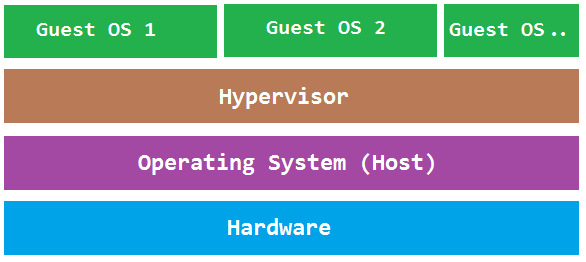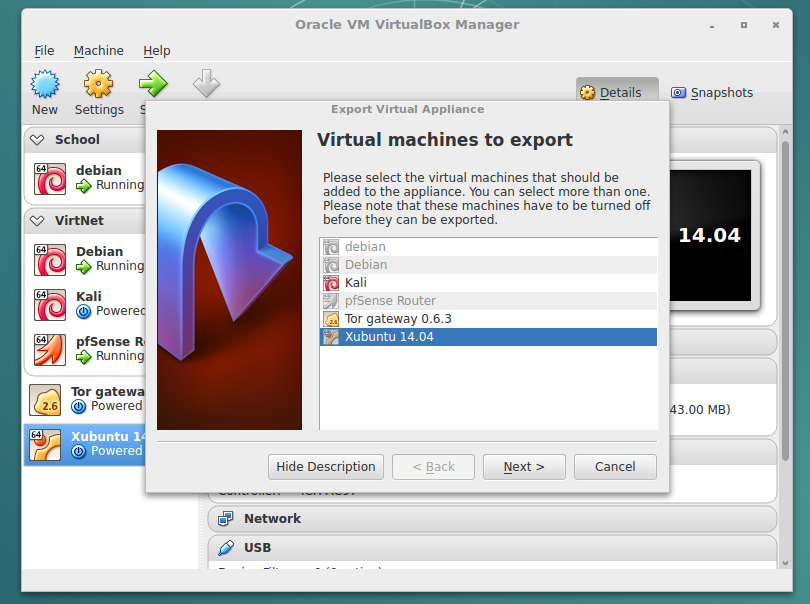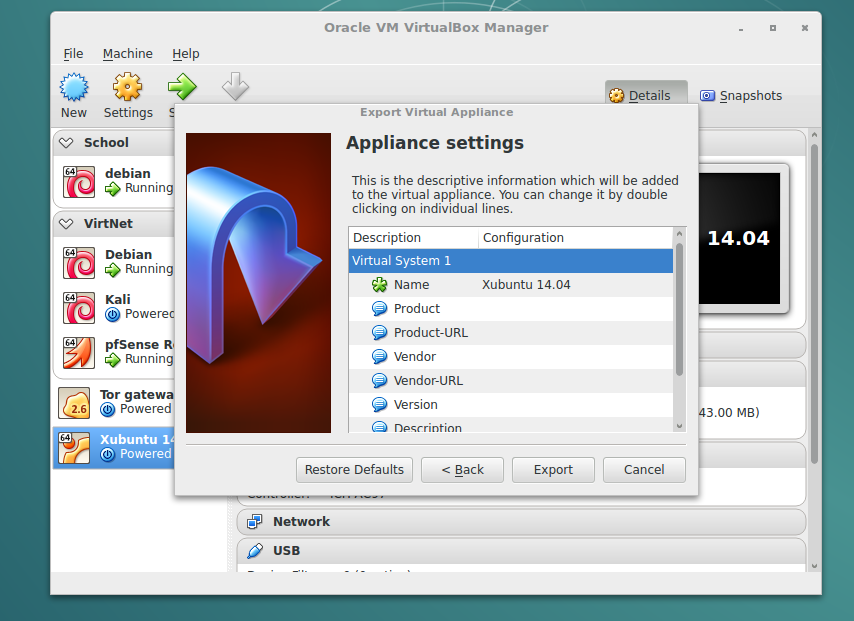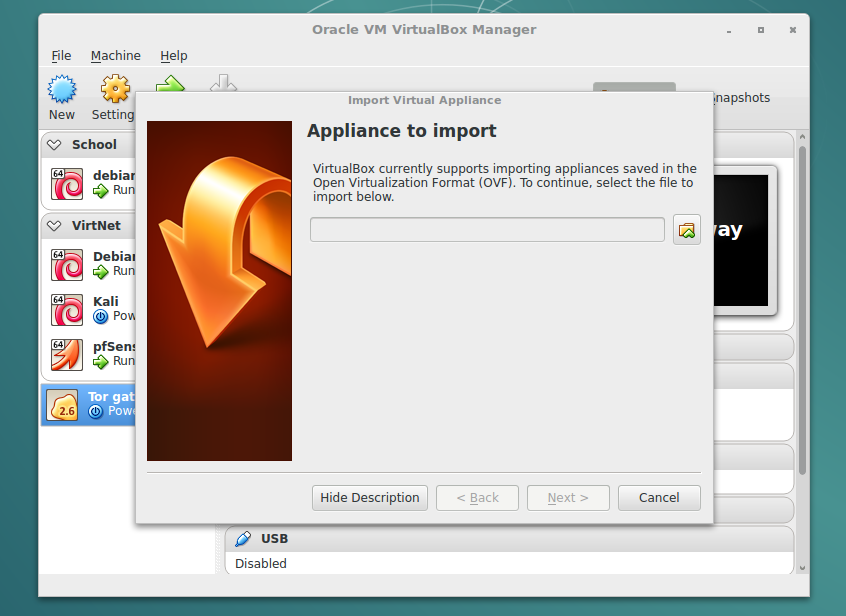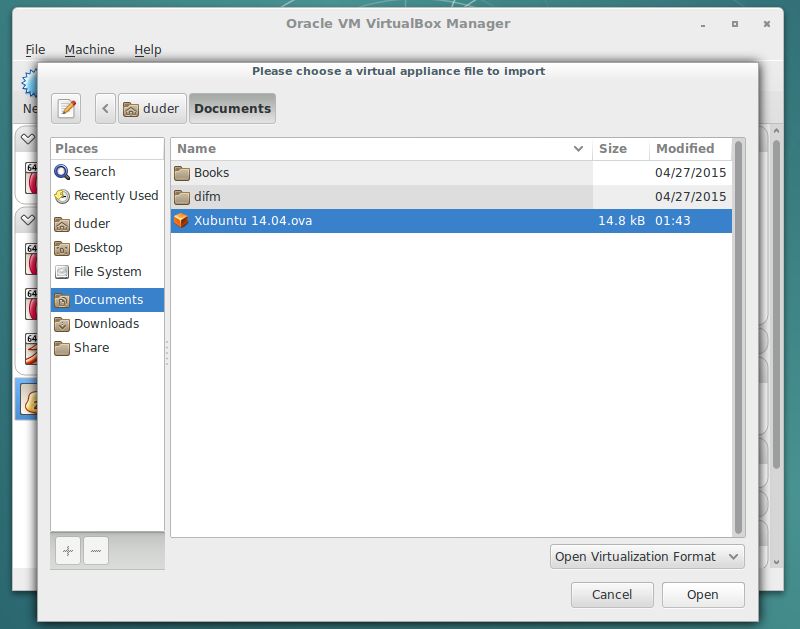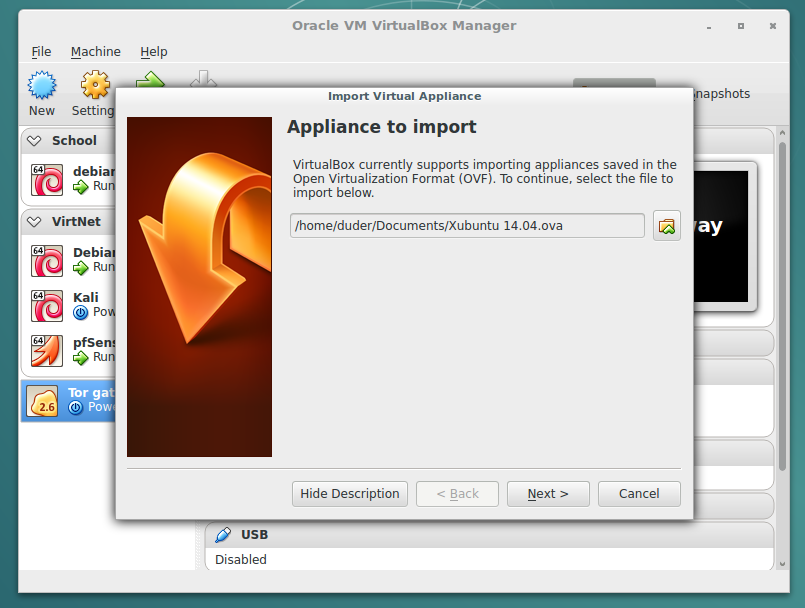User Tools
Sidebar
This is an old revision of the document!
Table of Contents
Dan's Wiki/Research Journal
This Wiki is a dedicated space for documenting my projects and research!
Hypervisors
I have decided to document the setup, usage, and performace differences of multiple hypervisors.
Hypervisors can be broken down into two types:
- Type-1: Native or bare metal hypervisors
- Type-2: Hosted hypervisors
Type-1
Type-1 hypervisors run directly on the host hardware allowing for hardware control and guest OS managability. Guest operating systmes are then run as processes on the host.
Examples of Type-1 hypervisors:
Type-2
Type-2 hypervisors run on top of existing operating systems much like web browsers or email clients. the hypervisor is then completely dependent upon the host operating system for its functionality.
Examples of Type-2 hypervisors:
Basic System Overview
To get this project going i decided to use one of my personal servers. This is the system i will be using for all testing as to keep a consistent approach to each hypervisor i test. System:
- Opteron 1385 Quadcore CPU
- 16GB of 800mhz DDR2
- 6x1TB 7200RPM HDDs
- Software Raid 10
OS:
- Debian 8 (Jessie)
KVM
The first hypervisor i will be testing is KVM (Kernal Based Virtual Machine)
Step 1. Install KVM & Libvirt from Debian Repository
apt-get install qemu-kvm libvirt-bin
Step 2. To be able to manage virtual machines as a non-root user we will need to add our account to the groups kvm and libvirt
adduser "username" kvm adduser "username" libvirt
Thats it! Now KVM is ready!
Management Options
KVM can be managed in multiple ways. The most popular approach is mgmt directly from the Linux CLI using virsh. (This is why we installed Libvirt)
duder@hyper1:~$ virsh --connect qemu:///system
Welcome to virsh, the virtualization interactive terminal.
Type: 'help' for help with commands
'quit' to quit
virsh # list --all
Id Name State
----------------------------------------------------
2 win7pro running
3 Win2012R2 running
virsh #
virsh # help
Grouped commands:
Domain Management (help keyword 'domain'):
attach-device attach device from an XML file
attach-disk attach disk device
attach-interface attach network interface
autostart autostart a domain
blkdeviotune Set or query a block device I/O tuning parameters.
blkiotune Get or set blkio parameters
blockcommit Start a block commit operation.
blockcopy Start a block copy operation.
blockjob Manage active block operations
blockpull Populate a disk from its backing image.
blockresize Resize block device of domain.
change-media Change media of CD or floppy drive
console connect to the guest console
cpu-baseline compute baseline CPU
cpu-compare compare host CPU with a CPU described by an XML file
cpu-stats show domain cpu statistics
create create a domain from an XML file
define define (but don't start) a domain from an XML file
desc show or set domain's description or title
destroy destroy (stop) a domain
detach-device detach device from an XML file
detach-disk detach disk device
detach-interface detach network interface
domdisplay domain display connection URI
domfsfreeze Freeze domain's mounted filesystems.
domfsthaw Thaw domain's mounted filesystems.
domfstrim Invoke fstrim on domain's mounted filesystems.
domhostname print the domain's hostname
domid convert a domain name or UUID to domain id
domif-setlink set link state of a virtual interface
domiftune get/set parameters of a virtual interface
domjobabort abort active domain job
domjobinfo domain job information
domname convert a domain id or UUID to domain name
dompmsuspend suspend a domain gracefully using power management functions
dompmwakeup wakeup a domain from pmsuspended state
domuuid convert a domain name or id to domain UUID
domxml-from-native Convert native config to domain XML
domxml-to-native Convert domain XML to native config
dump dump the core of a domain to a file for analysis
dumpxml domain information in XML
edit edit XML configuration for a domain
event Domain Events
inject-nmi Inject NMI to the guest
send-key Send keycodes to the guest
send-process-signal Send signals to processes
lxc-enter-namespace LXC Guest Enter Namespace
managedsave managed save of a domain state
managedsave-remove Remove managed save of a domain
memtune Get or set memory parameters
metadata show or set domain's custom XML metadata
migrate migrate domain to another host
migrate-setmaxdowntime set maximum tolerable downtime
migrate-compcache get/set compression cache size
migrate-setspeed Set the maximum migration bandwidth
migrate-getspeed Get the maximum migration bandwidth
numatune Get or set numa parameters
qemu-attach QEMU Attach
qemu-monitor-command QEMU Monitor Command
qemu-monitor-event QEMU Monitor Events
qemu-agent-command QEMU Guest Agent Command
reboot reboot a domain
reset reset a domain
restore restore a domain from a saved state in a file
resume resume a domain
save save a domain state to a file
save-image-define redefine the XML for a domain's saved state file
save-image-dumpxml saved state domain information in XML
save-image-edit edit XML for a domain's saved state file
schedinfo show/set scheduler parameters
screenshot take a screenshot of a current domain console and store it into a file
setmaxmem change maximum memory limit
setmem change memory allocation
setvcpus change number of virtual CPUs
shutdown gracefully shutdown a domain
start start a (previously defined) inactive domain
suspend suspend a domain
ttyconsole tty console
undefine undefine a domain
update-device update device from an XML file
vcpucount domain vcpu counts
vcpuinfo detailed domain vcpu information
vcpupin control or query domain vcpu affinity
emulatorpin control or query domain emulator affinity
vncdisplay vnc display
Domain Monitoring (help keyword 'monitor'):
domblkerror Show errors on block devices
domblkinfo domain block device size information
domblklist list all domain blocks
domblkstat get device block stats for a domain
domcontrol domain control interface state
domif-getlink get link state of a virtual interface
domiflist list all domain virtual interfaces
domifstat get network interface stats for a domain
dominfo domain information
dommemstat get memory statistics for a domain
domstate domain state
domstats get statistics about one or multiple domains
domtime domain time
list list domains
Host and Hypervisor (help keyword 'host'):
allocpages Manipulate pages pool size
capabilities capabilities
cpu-models CPU models
domcapabilities domain capabilities
freecell NUMA free memory
freepages NUMA free pages
hostname print the hypervisor hostname
maxvcpus connection vcpu maximum
node-memory-tune Get or set node memory parameters
nodecpumap node cpu map
nodecpustats Prints cpu stats of the node.
nodeinfo node information
nodememstats Prints memory stats of the node.
nodesuspend suspend the host node for a given time duration
sysinfo print the hypervisor sysinfo
uri print the hypervisor canonical URI
version show version
Interface (help keyword 'interface'):
iface-begin create a snapshot of current interfaces settings, which can be later committed (iface-commit) or restored (iface-rollback)
iface-bridge create a bridge device and attach an existing network device to it
iface-commit commit changes made since iface-begin and free restore point
iface-define define (but don't start) a physical host interface from an XML file
iface-destroy destroy a physical host interface (disable it / "if-down")
iface-dumpxml interface information in XML
iface-edit edit XML configuration for a physical host interface
iface-list list physical host interfaces
iface-mac convert an interface name to interface MAC address
iface-name convert an interface MAC address to interface name
iface-rollback rollback to previous saved configuration created via iface-begin
iface-start start a physical host interface (enable it / "if-up")
iface-unbridge undefine a bridge device after detaching its slave device
iface-undefine undefine a physical host interface (remove it from configuration)
Network Filter (help keyword 'filter'):
nwfilter-define define or update a network filter from an XML file
nwfilter-dumpxml network filter information in XML
nwfilter-edit edit XML configuration for a network filter
nwfilter-list list network filters
nwfilter-undefine undefine a network filter
Networking (help keyword 'network'):
net-autostart autostart a network
net-create create a network from an XML file
net-define define (but don't start) a network from an XML file
net-destroy destroy (stop) a network
net-dhcp-leases print lease info for a given network
net-dumpxml network information in XML
net-edit edit XML configuration for a network
net-event Network Events
net-info network information
net-list list networks
net-name convert a network UUID to network name
net-start start a (previously defined) inactive network
net-undefine undefine a persistent network
net-update update parts of an existing network's configuration
net-uuid convert a network name to network UUID
Node Device (help keyword 'nodedev'):
nodedev-create create a device defined by an XML file on the node
nodedev-destroy destroy (stop) a device on the node
nodedev-detach detach node device from its device driver
nodedev-dumpxml node device details in XML
nodedev-list enumerate devices on this host
nodedev-reattach reattach node device to its device driver
nodedev-reset reset node device
Secret (help keyword 'secret'):
secret-define define or modify a secret from an XML file
secret-dumpxml secret attributes in XML
secret-get-value Output a secret value
secret-list list secrets
secret-set-value set a secret value
secret-undefine undefine a secret
Snapshot (help keyword 'snapshot'):
snapshot-create Create a snapshot from XML
snapshot-create-as Create a snapshot from a set of args
snapshot-current Get or set the current snapshot
snapshot-delete Delete a domain snapshot
snapshot-dumpxml Dump XML for a domain snapshot
snapshot-edit edit XML for a snapshot
snapshot-info snapshot information
snapshot-list List snapshots for a domain
snapshot-parent Get the name of the parent of a snapshot
snapshot-revert Revert a domain to a snapshot
Storage Pool (help keyword 'pool'):
find-storage-pool-sources-as find potential storage pool sources
find-storage-pool-sources discover potential storage pool sources
pool-autostart autostart a pool
pool-build build a pool
pool-create-as create a pool from a set of args
pool-create create a pool from an XML file
pool-define-as define a pool from a set of args
pool-define define (but don't start) a pool from an XML file
pool-delete delete a pool
pool-destroy destroy (stop) a pool
pool-dumpxml pool information in XML
pool-edit edit XML configuration for a storage pool
pool-info storage pool information
pool-list list pools
pool-name convert a pool UUID to pool name
pool-refresh refresh a pool
pool-start start a (previously defined) inactive pool
pool-undefine undefine an inactive pool
pool-uuid convert a pool name to pool UUID
Storage Volume (help keyword 'volume'):
vol-clone clone a volume.
vol-create-as create a volume from a set of args
vol-create create a vol from an XML file
vol-create-from create a vol, using another volume as input
vol-delete delete a vol
vol-download download volume contents to a file
vol-dumpxml vol information in XML
vol-info storage vol information
vol-key returns the volume key for a given volume name or path
vol-list list vols
vol-name returns the volume name for a given volume key or path
vol-path returns the volume path for a given volume name or key
vol-pool returns the storage pool for a given volume key or path
vol-resize resize a vol
vol-upload upload file contents to a volume
vol-wipe wipe a vol
Virsh itself (help keyword 'virsh'):
cd change the current directory
connect (re)connect to hypervisor
echo echo arguments
exit quit this interactive terminal
help print help
pwd print the current directory
quit quit this interactive terminal
virsh #
Another approach is to use managment software. I currently use Virtual Machine Manager.
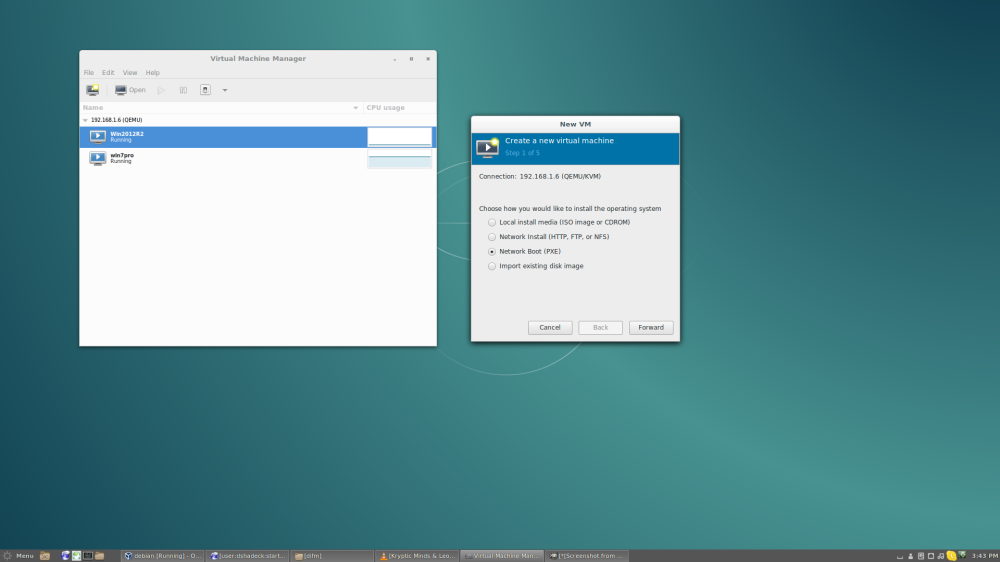
What now?
I installed KVM at the start of the semester and have yet to switch to another hypervisor!
My next step is to move to a USB bootable Xen hypervisor!
Virtual Box
This semester i have been using Virtual Box for many things school and personal related. It has become a valuable tool and has changed the way i use computers!
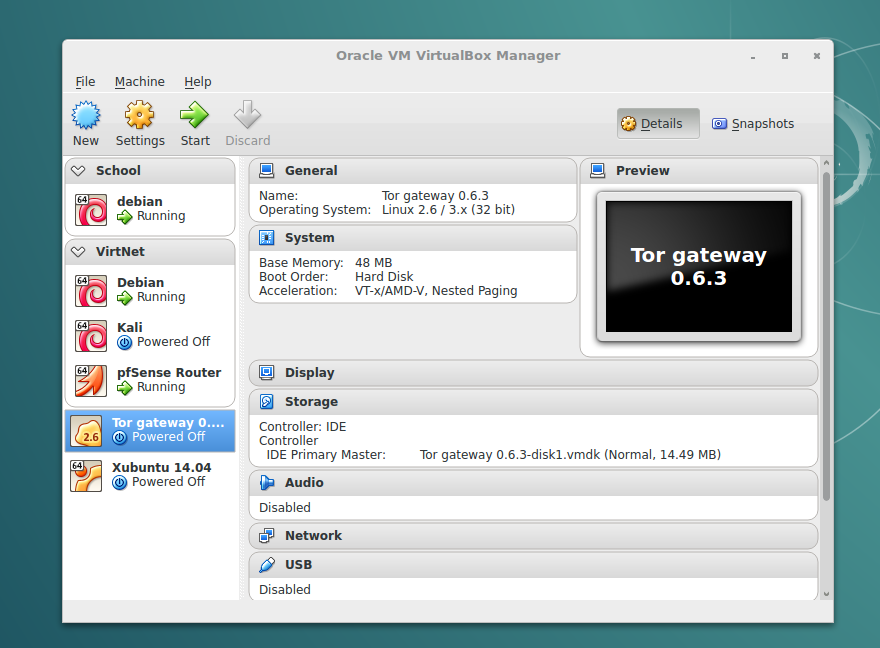
Exporting/Importing VMs
Exporting is a great feature built into Virtual Box that allows for easy back up of virtual machines.
- Select where to save the VM. Here we can also chose wich version of OVF to use. This will save our VM in open virtualization format inside of an OVA (this is essentialy a tar file). Lastly you can select “Write Manifest File” if you would like virtualbox to automaticly run data integrity checks when importing. When finished select next.
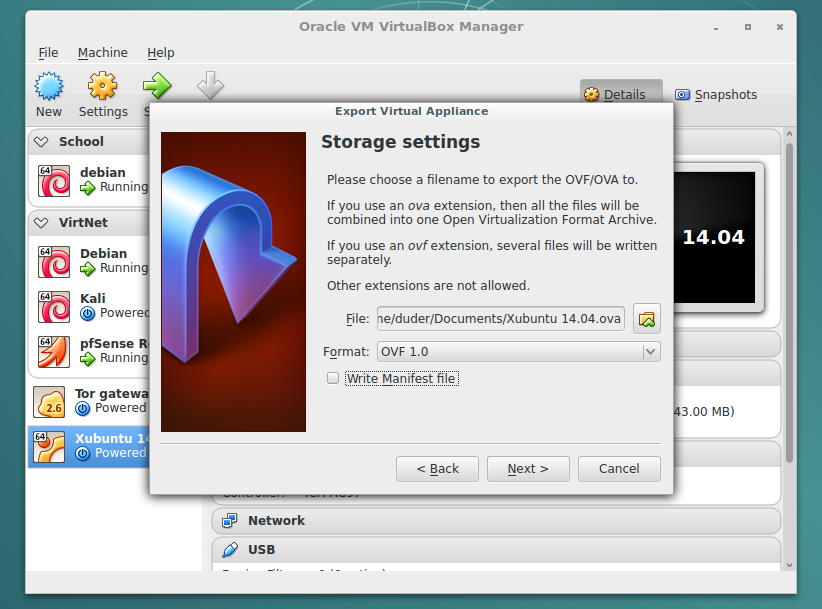
Now we can use our exported VM to learn about importing!
- Here we can see all of the predefined settings of our VM. Make sure these settings are compatable with your computer. We also have the option to reinitilize the MAC address of the VMs NICs. when importing the same VM multiple times it is important to select this option to avoid confilcting MACS on your network. When finished select Import to finish.
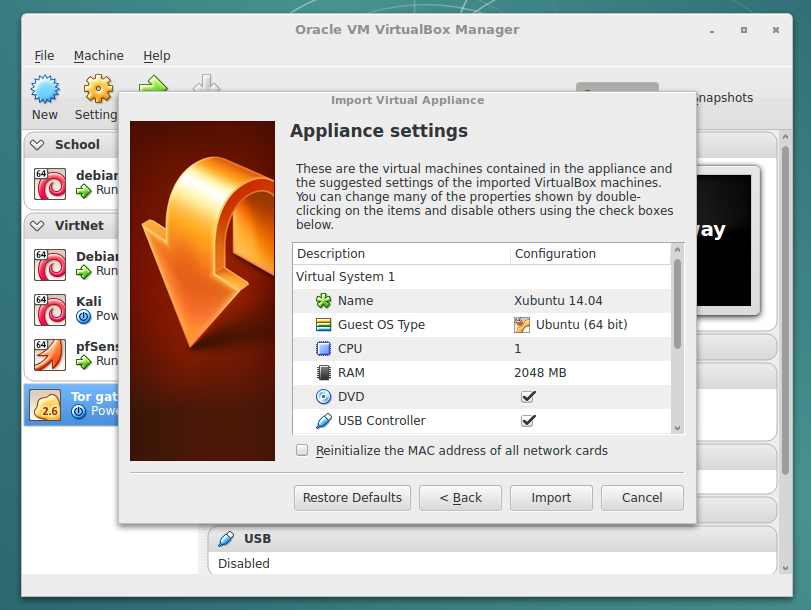
Data Bases
This past week i have been spending some time learning about the DB server and how to make the move to Debian 8 and MariaDB as smooth as possible. I learned quickly that backing up all of the databases will be an easy task to accomplish. This can be achieved with something along the lines of this command:
mysqldump --all-databases > all_databases.sql
Where the real problem lies is the compatibility between older versions of MySQL and MariaDB. Because we are running MySQL 5.1 we can only move our database back up to MariaDB 5.5… While this shouldn't be to much of an issue we are really shooting to use MariaDB 10. This is the latest stable version and is packaged in the Debian repos. I have encountered some methods of moving 5.5 database backups to 10 but it looks like a long tedious process. NOT FUN.
Datacom
<charter> title = Simple 3D pie chart size = 400×300 align = center bgcolor = #eeeeee type = pie3d labelSerie = 2 pieExploded = on
25,46,20,6,3 Jan, Feb, Mar, Apr, May </charter>


